Exhibit 99.2

Nasdaq: VANI www.vivani.com March 2025
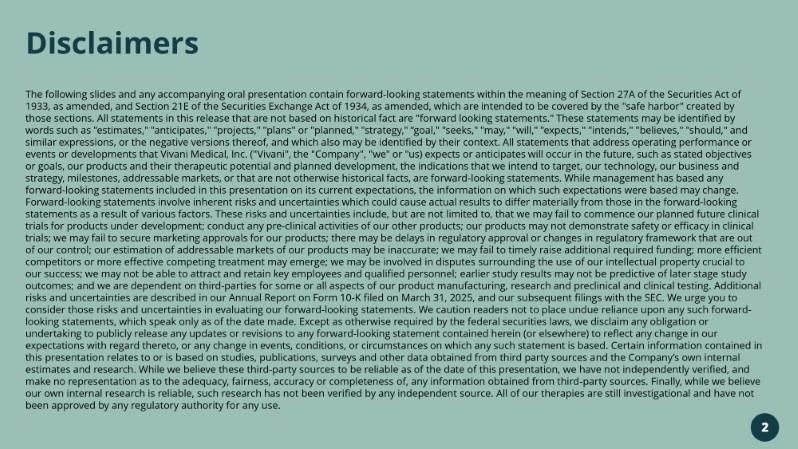
Disclaimers The following slides and any accompanying oral presentation contain forward-looking statements within the meaning of Section 27A of the Securities Act of 1933, as amended, and Section 21E of the Securities Exchange Act of 1934, as amended, which are intended to be covered by the "safe harbor" created by those sections. All statements in this release that are not based on historical fact are "forward looking statements." These statements may be identified by words such as "estimates," "anticipates," "projects," "plans" or "planned," "strategy," “goal," "seeks," "may," "will," "expects," "intends," "believes," "should," and similar expressions, or the negative versions thereof, and which also may be identified by their context. All statements that address operating performance or events or developments that Vivani Medical, Inc. ("Vivani", the "Company", "we" or "us) expects or anticipates will occur in the future, such as stated objectives or goals, our products and their therapeutic potential and planned development, the indications that we intend to target, our technology, our business and strategy, milestones, addressable markets, or that are not otherwise historical facts, are forward-looking statements. While management has based any forward-looking statements included in this presentation on its current expectations, the information on which such expectations were based may change. Forward-looking statements involve inherent risks and uncertainties which could cause actual results to differ materially from those in the forward-looking statements as a result of various factors. These risks and uncertainties include, but are not limited to, that we may fail to commence our planned future clinical trials for products under development; conduct any pre-clinical activities of our other products; our products may not demonstrate safety or efficacy in clinical trials; we may fail to secure marketing approvals for our products; there may be delays in regulatory approval or changes in regulatory framework that are out of our control; our estimation of addressable markets of our products may be inaccurate; we may fail to timely raise additional required funding; more efficient competitors or more effective competing treatment may emerge; we may be involved in disputes surrounding the use of our intellectual property crucial to our success; we may not be able to attract and retain key employees and qualified personnel; earlier study results may not be predictive of later stage study outcomes; and we are dependent on third-parties for some or all aspects of our product manufacturing, research and preclinical and clinical testing. Additional risks and uncertainties are described in our Annual Report on Form 10-K filed on March 31, 2025, and our subsequent filings with the SEC. We urge you to consider those risks and uncertainties in evaluating our forward-looking statements. We caution readers not to place undue reliance upon any such forwardlooking statements, which speak only as of the date made. Except as otherwise required by the federal securities laws, we disclaim any obligation or undertaking to publicly release any updates or revisions to any forward-looking statement contained herein (or elsewhere) to reflect any change in our expectations with regard thereto, or any change in events, conditions, or circumstances on which any such statement is based. Certain information contained in this presentation relates to or is based on studies, publications, surveys and other data obtained from third party sources and the Company’s own internal estimates and research. While we believe these third-party sources to be reliable as of the date of this presentation, we have not independently verified, and make no representation as to the adequacy, fairness, accuracy or completeness of, any information obtained from third-party sources. Finally, while we believe our own internal research is reliable, such research has not been verified by any independent source. All of our therapies are still investigational and have not been approved by any regulatory authority for any use.
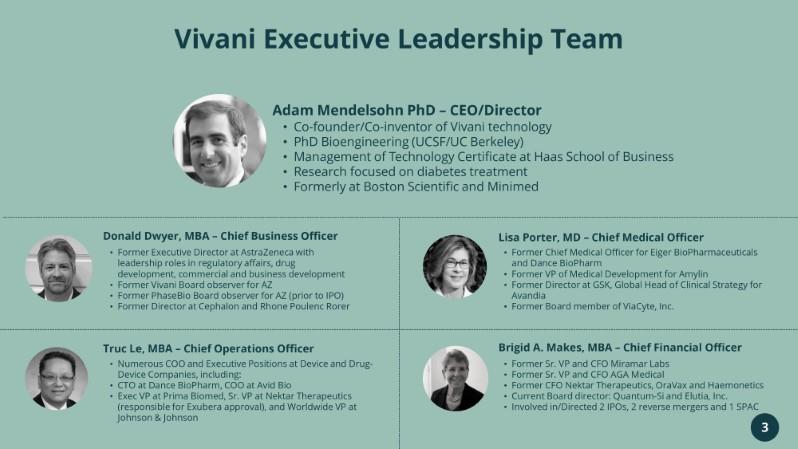
Vivani Executive Leadership Team • Co-founder/Co-inventor of Vivani technology • PhD Bioengineering (UCSF/UC Berkeley) • Management of Technology Certificate at Haas School of Business • Research focused on diabetes treatment • Formerly at Boston Scientific and Minimed Adam Mendelsohn PhD – CEO/Director • Numerous COO and Executive Positions at Device and DrugDevice Companies, including: • CTO at Dance BioPharm, COO at Avid Bio • Exec VP at Prima Biomed, Sr. VP at Nektar Therapeutics (responsible for Exubera approval), and Worldwide VP at Johnson & Johnson Truc Le, MBA – Chief Operations Officer • Former Chief Medical Officer for Eiger BioPharmaceuticals and Dance BioPharm • Former VP of Medical Development for Amylin • Former Director at GSK, Global Head of Clinical Strategy for Avandia • Former Board member of ViaCyte, Inc. Lisa Porter, MD – Chief Medical Officer • Former Sr. VP and CFO Miramar Labs • Former Sr. VP and CFO AGA Medical • Former CFO Nektar Therapeutics, OraVax and Haemonetics • Current Board director: Quantum-Si and Elutia, Inc. • Involved in/Directed 2 IPOs, 2 reverse mergers and 1 SPAC
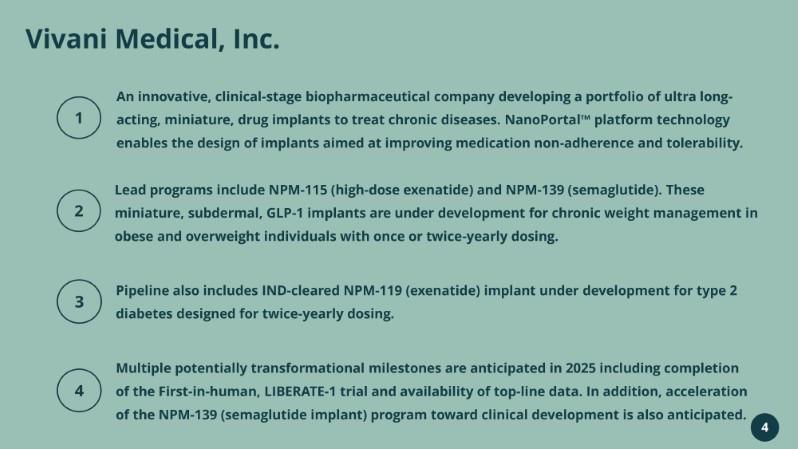
Vivani Medical, Inc. 4 Lead programs include NPM-115 (high-dose exenatide) and NPM-139 (semaglutide). These miniature, subdermal, GLP-1 implants are under development for chronic weight management in obese and overweight individuals with once or twice-yearly dosing. Pipeline also includes IND-cleared NPM-119 (exenatide) implant under development for type 2 diabetes designed for twice-yearly dosing. An innovative, clinical-stage biopharmaceutical company developing a portfolio of ultra longacting, miniature, drug implants to treat chronic diseases. NanoPortal platform technology enables the design of implants aimed at improving medication non-adherence and tolerability. Multiple potentially transformational milestones are anticipated in 2025 including completion of the First-in-human, LIBERATE-1 trial and availability of top-line data. In addition, acceleration of the NPM-139 (semaglutide implant) program toward clinical development is also anticipated.
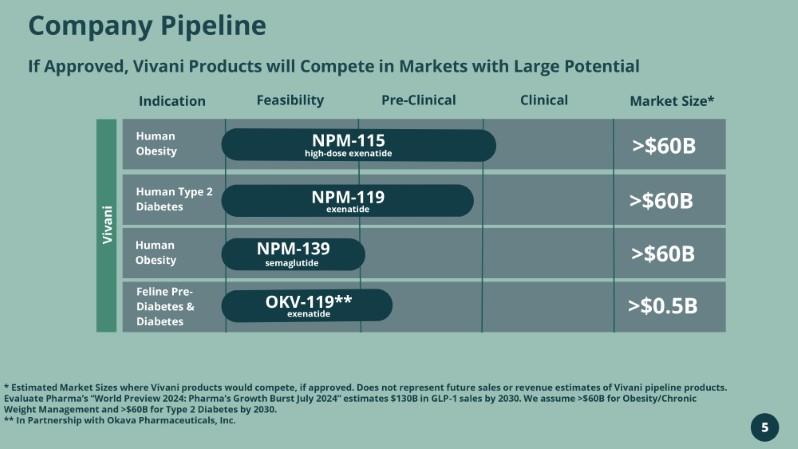
Company Pipeline If Approved, Vivani Products will Compete in Markets with Large Potential Indication Feasibility Pre-Clinical Clinical Market Size* Human Type 2 Diabetes Human Obesity NPM-119 exenatide >$60B NPM-139 >$60B Vivani * Estimated Market Sizes where Vivani products would compete, if approved. Does not represent future sales or revenue estimates of Vivani pipeline products. Evaluate Pharma’s “World Preview 2024: Pharma’s Growth Burst July 2024” estimates $130B in GLP-1 sales by 2030. We assume >$60B for Obesity/Chronic Weight Management and >$60B for Type 2 Diabetes by 2030. ** In Partnership with Okava Pharmaceuticals, Inc.

Drug Implants Proprietary Platform Technology
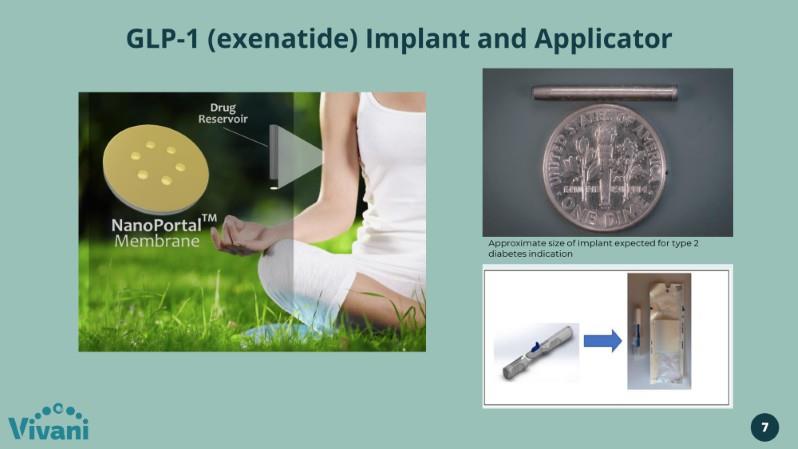
GLP-1 (exenatide) Implant and Applicator 7 Approximate size of implant expected for type 2 diabetes indication
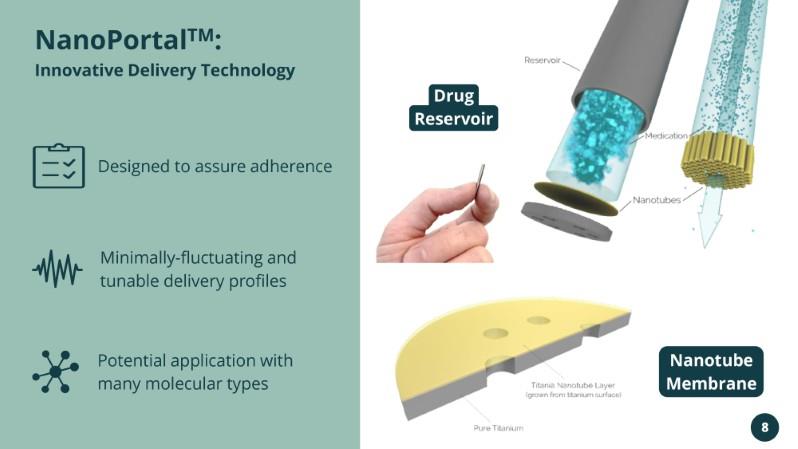
Designed to assure adherence Minimally-fluctuating and tunable delivery profiles Potential application with many molecular types
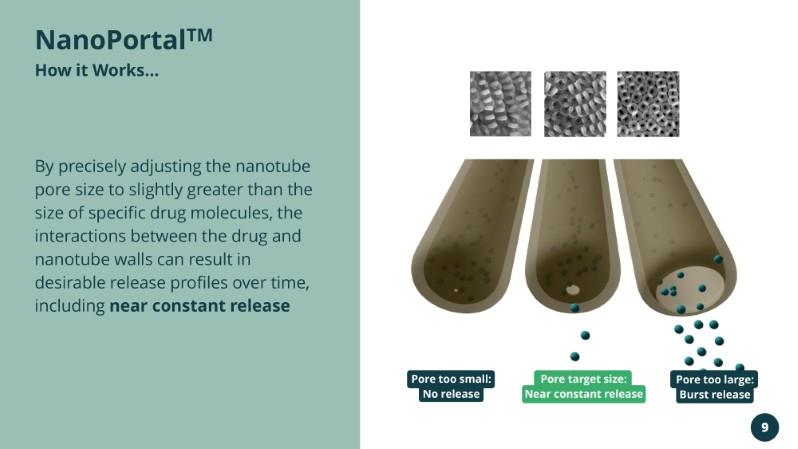
NanoPortalTM How it Works...By precisely adjusting the nanotube pore size to slightly greater than the size of specific drug molecules, the interactions between the drug and nanotube walls can result in desirable release profiles over time, including near constant release
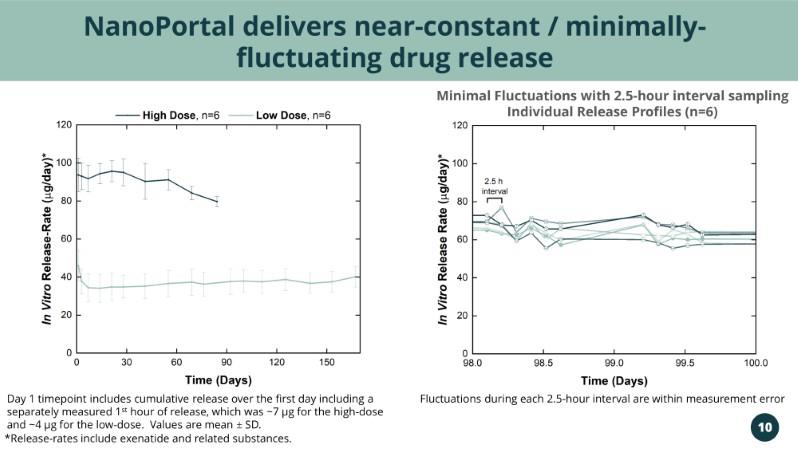
NanoPortal delivers near-constant / minimallyfluctuating drug release Day 1 timepoint includes cumulative release over the first day including a separately measured 1st hour of release, which was ~7 µg for the high-dose and ~4 µg for the low-dose. Values are mean ± SD. Fluctuations during each 2.5-hour interval are within measurement error 10 Minimal Fluctuations with 2.5-hour interval sampling Individual Release Profiles (n=6) *Release-rates include exenatide and related substances.
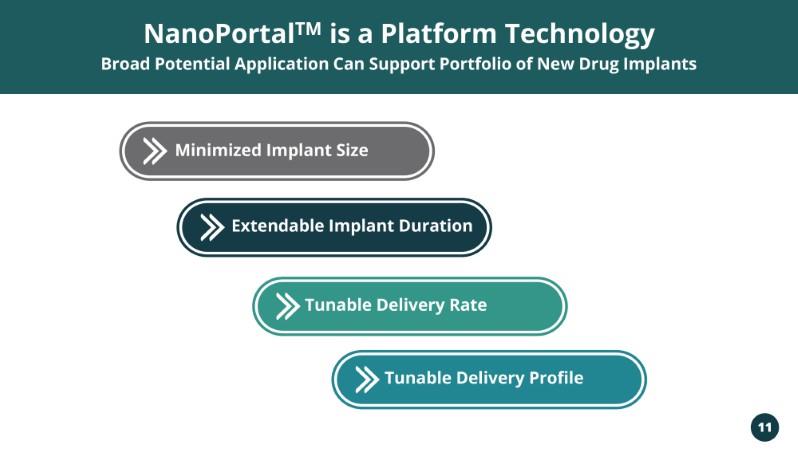
NanoPortalTM is a Platform Technology Broad Potential Application Can Support Portfolio of New Drug Implants Minimized Implant Size Extendable Implant Duration Tunable Delivery Rate Tunable Delivery Profile
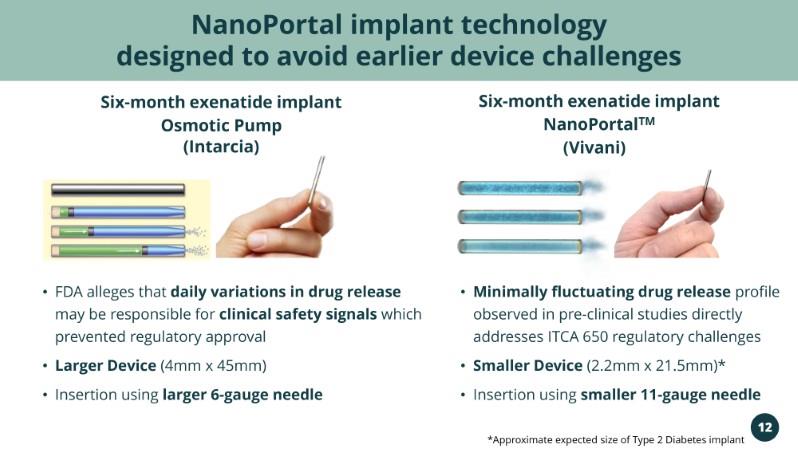
(Intarcia) • FDA alleges that daily variations in drug release may be responsible for clinical safety signals which prevented regulatory approval • Larger Device (4mm x 45mm) • Insertion using larger 6-gauge needle • Minimally fluctuating drug release profile observed in pre-clinical studies directly addresses ITCA 650 regulatory challenges • Smaller Device (2.2mm x 21.5mm)* • Insertion using smaller 11-gauge needle NanoPortal implant technology designed to avoid earlier device challenges Six-month exenatide implant NanoPortalTM Six-month exenatide implant Osmotic Pump
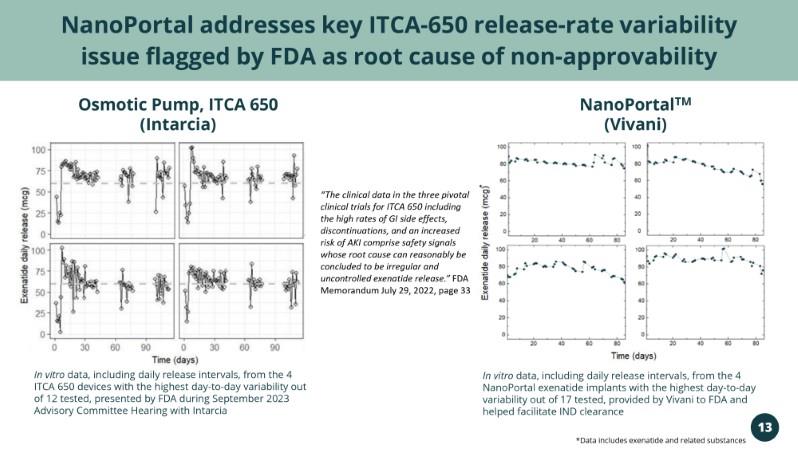
NanoPortal addresses key ITCA-650 release-rate variability issue flagged by FDA as root cause of non-approvability (Intarcia) Osmotic Pump, ITCA 650 NanoPortalTM (Vivani) 13 “The clinical data in the three pivotal clinical trials for ITCA 650 including the high rates of GI side effects, discontinuations, and an increased risk of AKI comprise safety signals whose root cause can reasonably be concluded to be irregular and uncontrolled exenatide release.” FDA Memorandum July 29, 2022, page 33 * *Data includes exenatide and related substances In vitro data, including daily release intervals, from the 4 NanoPortal exenatide implants with the highest day-to-day variability out of 17 tested, provided by Vivani to FDA and helped facilitate IND clearance In vitro data, including daily release intervals, from the 4 ITCA 650 devices with the highest day-to-day variability out of 12 tested, presented by FDA during September 2023 Advisory Committee Hearing with Intarcia
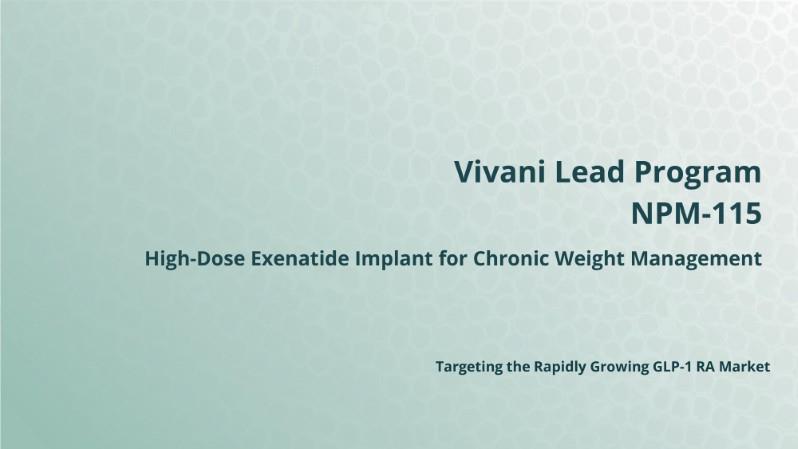
Vivani Lead Program NPM-115 High-Dose Exenatide Implant for Chronic Weight Management Targeting the Rapidly Growing GLP-1 RA Market
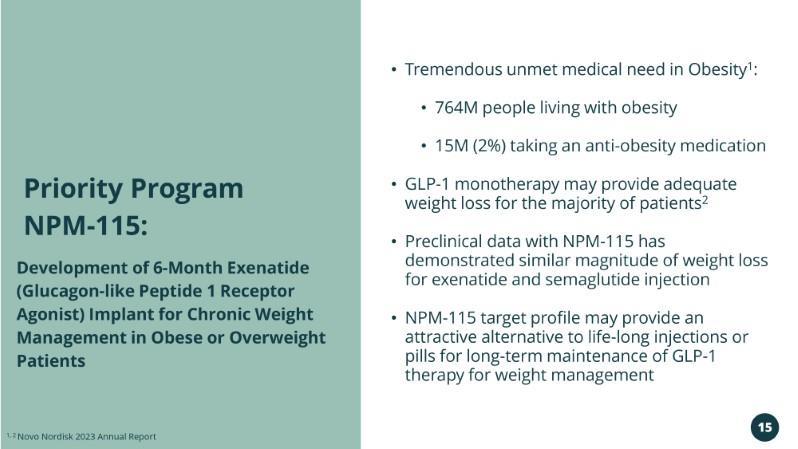
Priority Program NPM-115: Development of 6-Month Exenatide (Glucagon-like Peptide 1 Receptor Agonist) Implant for Chronic Weight Management in Obese or Overweight Patients • Tremendous unmet medical need in Obesity1 : • 764M people living with obesity • 15M (2%) taking an anti-obesity medication • GLP-1 monotherapy may provide adequate weight loss for the majority of patients2 • Preclinical data with NPM-115 has demonstrated similar magnitude of weight loss for exenatide and semaglutide injection • NPM-115 target profile may provide an attractive alternative to life-long injections or pills for long-term maintenance of GLP-1 therapy for weight management
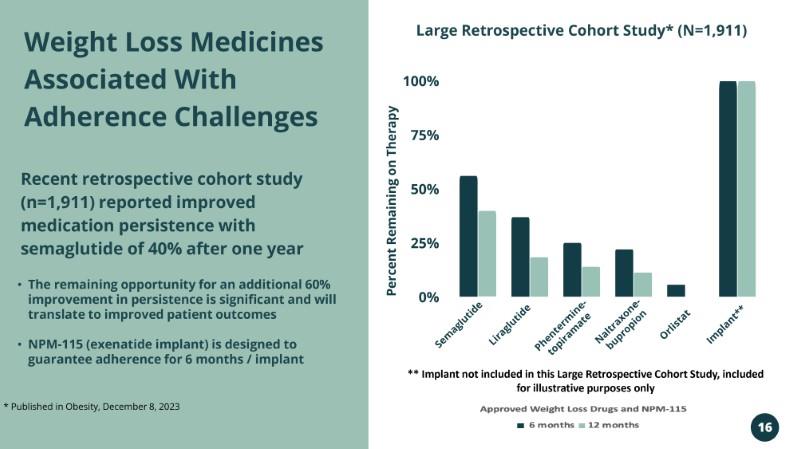
Weight Loss Medicines Associated With Adherence Challenges Recent retrospective cohort study (n=1,911) reported improved medication persistence with semaglutide of 40% after one year The remaining opportunity for an additional 60% improvement in persistence is significant and will translate to improved patient outcomes • NPM-115 (exenatide implant) is designed to guarantee adherence for 6 months / implant ** Implant not included in this Large Retrospective Cohort Study, included for illustrative purposes only
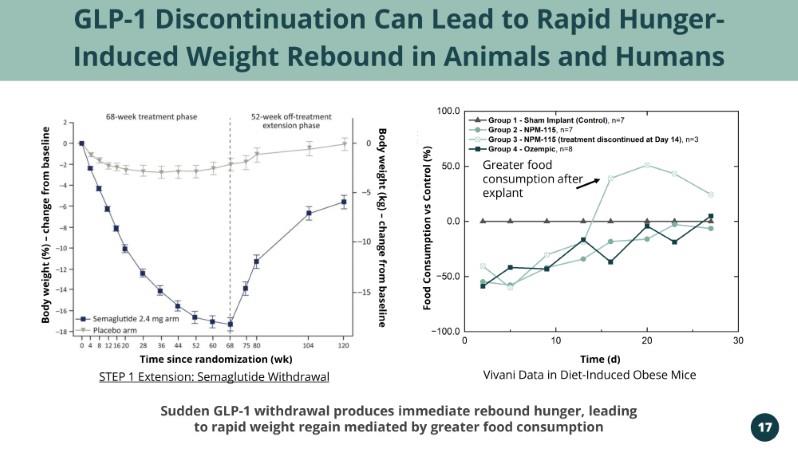
GLP-1 Discontinuation Can Lead to Rapid HungerInduced Weight Rebound in Animals and Huma Sudden GLP-1 withdrawal produces immediate rebound hunger, leading to rapid weight regain mediated by greater food consumption
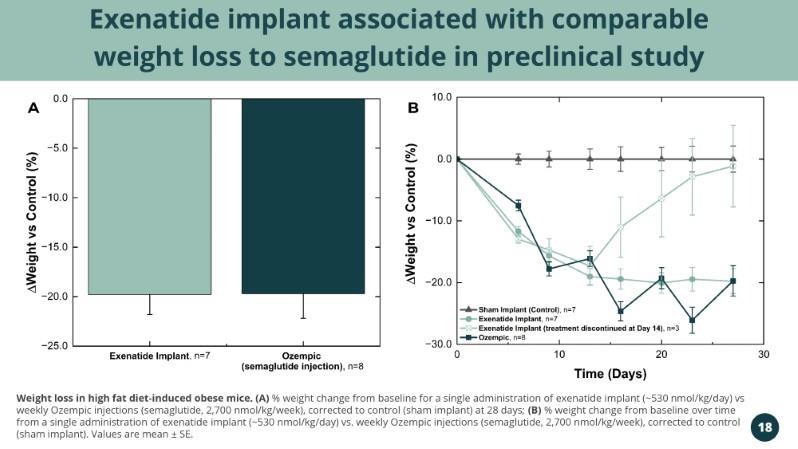
Exenatide implant associated with comparable weight loss to semaglutide in preclinical study 18 Weight loss in high fat diet-induced obese mice. (A) % weight change from baseline for a single administration of exenatide implant (~530 nmol/kg/day) vs weekly Ozempic injections (semaglutide, 2,700 nmol/kg/week), corrected to control (sham implant) at 28 days; (B) % weight change from baseline over time from a single administration of exenatide implant (~530 nmol/kg/day) vs. weekly Ozempic injections (semaglutide, 2,700 nmol/kg/week), corrected to control
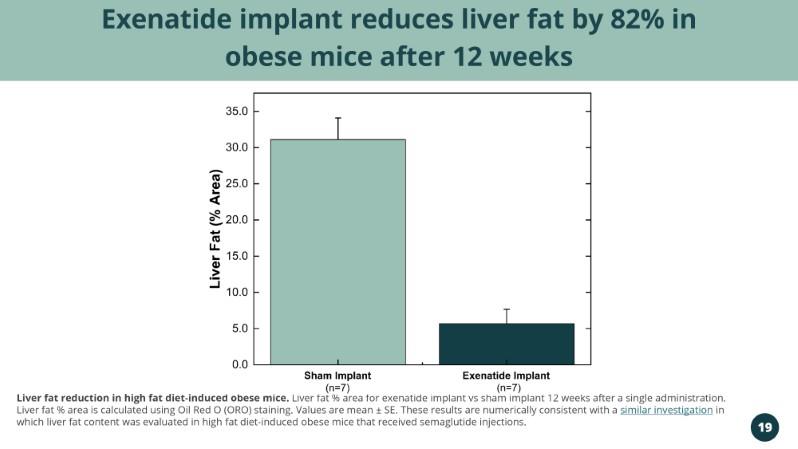
Exenatide implant reduces liver fat by 82% in obese mice after 12 weeks 19 Liver fat reduction in high fat diet-induced obese mice. Liver fat % area for exenatide implant vs sham implant 12 weeks after a single administration. Liver fat % area is calculated using Oil Red O (ORO) staining. Values are mean ± SE. These results are numerically consistent with a similar investigation in which liver fat content was evaluated in high fat diet-induced obese mice that received semaglutide injections.
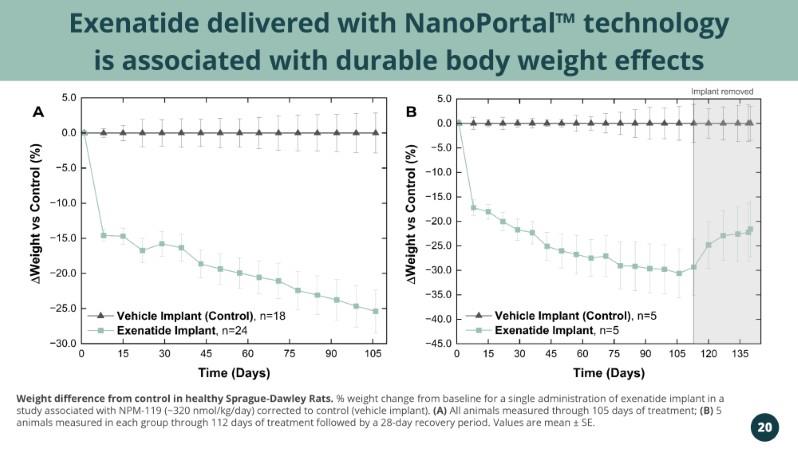
Exenatide delivered with NanoPortal technology is associated with durable body weight effects 20 Weight difference from control in healthy Sprague-Dawley Rats. % weight change from baseline for a single administration of exenatide implant in a study associated with NPM-119 (~320 nmol/kg/day) corrected to control (vehicle implant). (A) All animals measured through 105 days of treatment; (B) 5 animals measured in each group through 112 days of treatment followed by a 28-day recovery period. Values are mean ± SE.
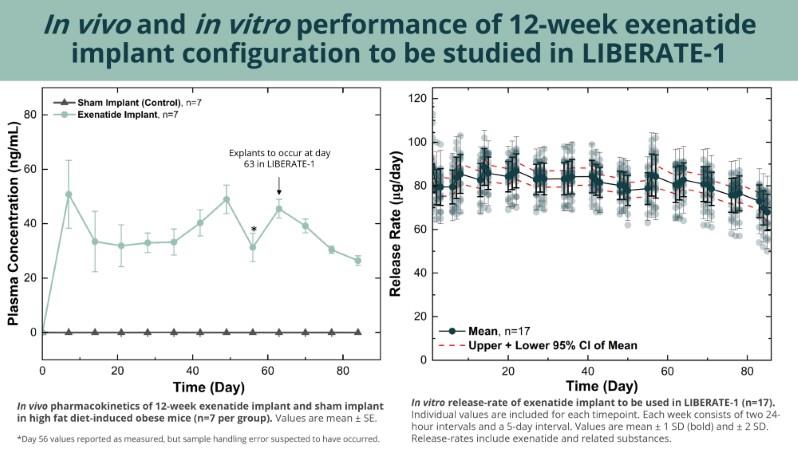
In vivo and in vitro performance of 12-week exenatide implant configuration to be studied in LIBERATE-1 In vivo pharmacokinetics of 12-week exenatide implant and sham implant in high fat diet-induced obese mice (n=7 per group). Values are mean ± SE. *Day 56 values reported as measured, but sample handling error suspected to have occurred. * Explants to occur at day 63 in LIBERATE-1 In vitro release-rate of exenatide implant to be used in LIBERATE-1 (n=17). Individual values are included for each timepoint. Each week consists of two 24- hour intervals and a 5-day interval. Values are mean ± 1 SD (bold) and ± 2 SD. Release-rates include exenatide and related substances.

6-Month exenatide implant preclinical proof-of-concept achieved Implants removed * 22 Pharmacokinetics of 6-month exenatide implant in male Sprague-Dawley rats (n=6) Exenatide antibody-positive animals are not included in this data set. Values are mean ± SD. *2 of 6 implants are responsible for higher Day 1 exenatide concentrations which is not expected to occur in the configuration to be used in the clinic. ** The estimated exenatide EC50 is 51.4 pg/mL when exenatide antibody titers are < 125 and 84 pg/mL when exenatide antibody titers are >= 125. These exenatide EC50 estimates are consistent with the exenatide EC50 estimate, 83.5 pg/mL, from the FDA Clinical Pharmacology review of BYDUREON
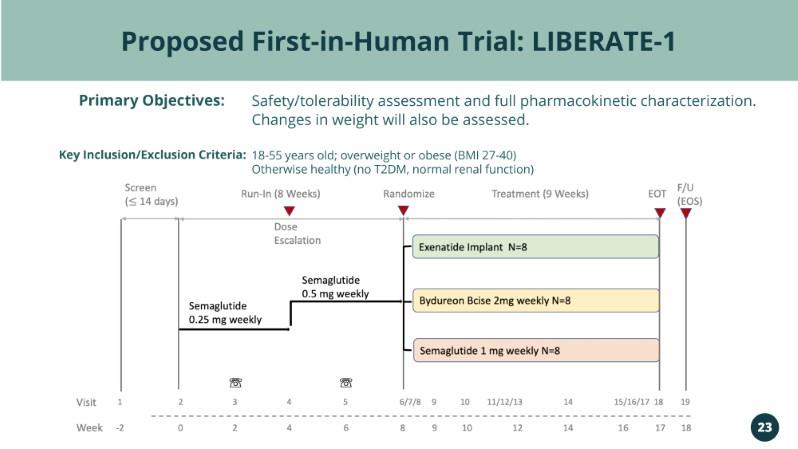
Proposed First-in-Human Trial: LIBERATE-1 Primary Objectives: NPM-119 (N=8) 23 Safety/tolerability assessment and full pharmacokinetic characterization. Changes in weight will also be assessed. Key Inclusion/Exclusion Criteria: 18-55 years old; overweight or obese (BMI 27-40) Otherwise healthy (no T2DM, normal renal function
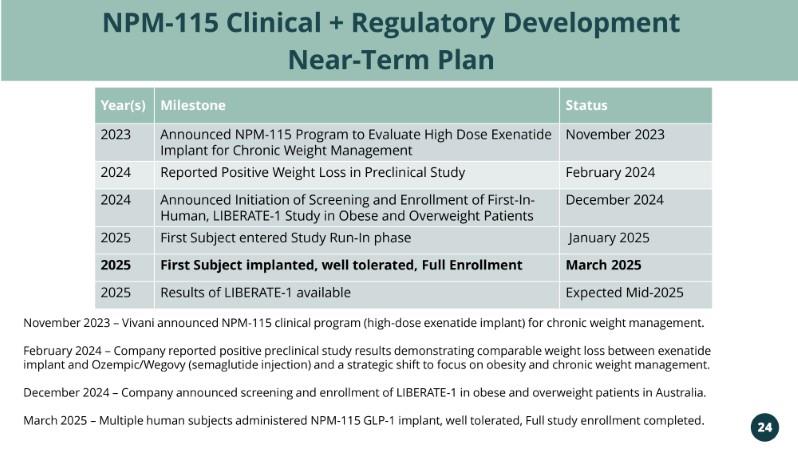
NPM-115 Clinical + Regulatory Development Near-Term Plan November 2023 – Vivani announced NPM-115 clinical program (high-dose exenatide implant) for chronic weight management. February 2024 – Company reported positive preclinical study results demonstrating comparable weight loss between exenatide implant and Ozempic/Wegovy (semaglutide injection) and a strategic shift to focus on obesity and chronic weight management. December 2024 – Company announced screening and enrollment of LIBERATE-1 in obese and overweight patients in Australia. March 2025 – Multiple human subjects administered NPM-115 GLP-1 implant, well tolerated, Full study enrollment completed. 24 Year(s) Milestone Status 2023 Announced NPM-115 Program to Evaluate High Dose Exenatide Implant for Chronic Weight Management November 2023 2024 Reported Positive Weight Loss in Preclinical Study February 2024 2024 Announced Initiation of Screening and Enrollment of First-InHuman, LIBERATE-1 Stu
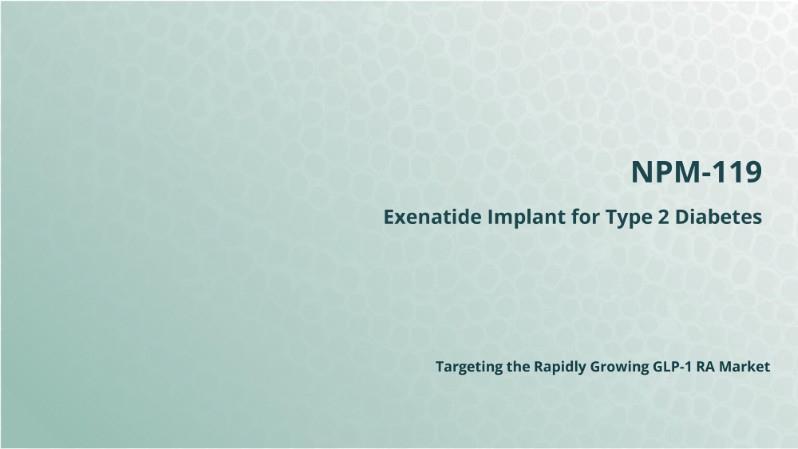
NPM-119 Exenatide Implant for Type 2 Diabetes
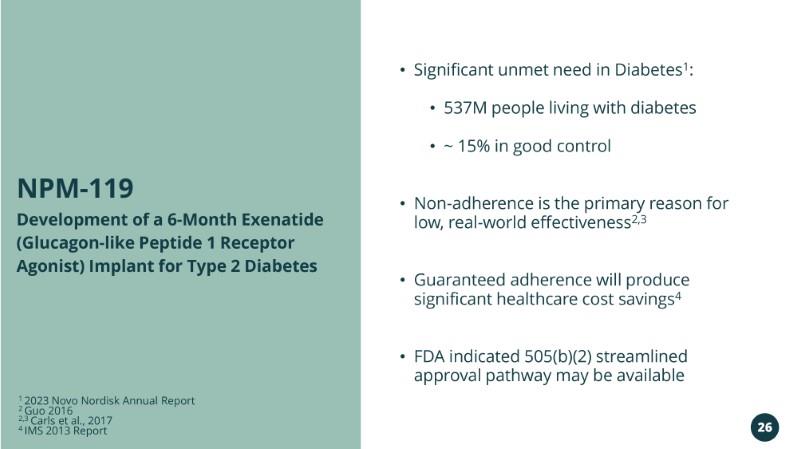
Significant unmet need in Diabetes1 : • 537M people living with diabetes • ~ 15% in good control • Non-adherence is the primary reason for low, real-world effectiveness2,3 • Guaranteed adherence will produce significant healthcare cost savings4 • FDA indicated 505(b)(2) streamlined approval pathway may be available Development of a 6-Month Exenatide (Glucagon-like Peptide 1 Receptor Agonist) Implant for Type 2 Diabetes
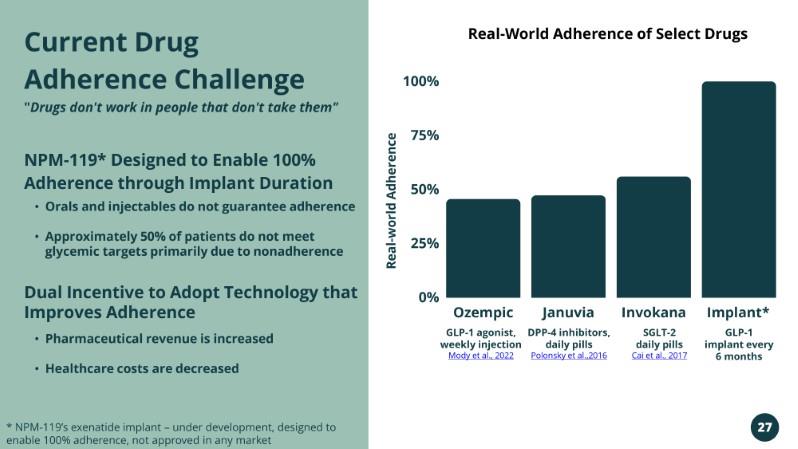
Current Drug Adherence Challenge "Drugs don't work in people that don't take them NPM-119* Designed to Enable 100% Adherence through Implant Duration Dual Incentive to Adopt Technology that Improves Adherence • Pharmaceutical revenue is increased • Healthcare costs are decreased Current Drug Adherence Challenge "Drugs don't work in people that don't take them" Real-world Adherence * NPM-119’s exenatide implant – under development, designed to enable 100% adherence, not approved in any market"

Patient research indicates strong adoption potential for a miniature, 6-month exenatide implant dQ&A insights reported market research during FDA Advisory Board to review ITCA 650 (exenatide implant) on September 21, 2023 28 56% of patients responded “likely” or “definitely” to get an exenatide implant if FDA approved, prescriber recommended, and covered by insurance
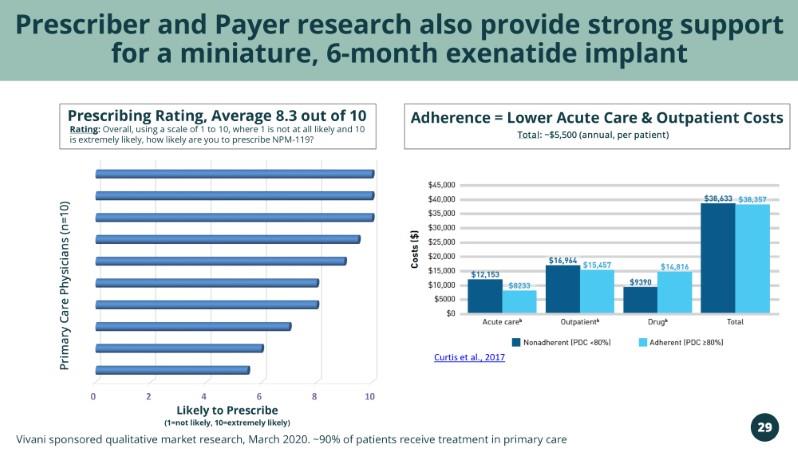
Prescriber and Payer research also provide strong support for a miniature, 6-month exenatide implant Rating: Overall, using a scale of 1 to 10, where 1 is not at all likely and 10 is extremely likely, how likely are you to prescribe NPM-119? Vivani sponsored qualitative market research, March 2020. ~90% of patients receive treatment in primary care

Development of once or twice-yearly Semaglutide (Glucagon-like Peptide 1 Receptor Agonist) Implant for Chronic Weight Management in Obese or Overweight Patients Semaglutide products Ozempic® and Wegovy® generated ~$25B in sales in 2024 • More than half of patients regularly miss doses based on real-world adherence data • NPM-139 is initially being designed for once or twice-yearly dosing. • In addition to obesity, the semaglutide implant is also under consideration for treatment of type 2 diabetes
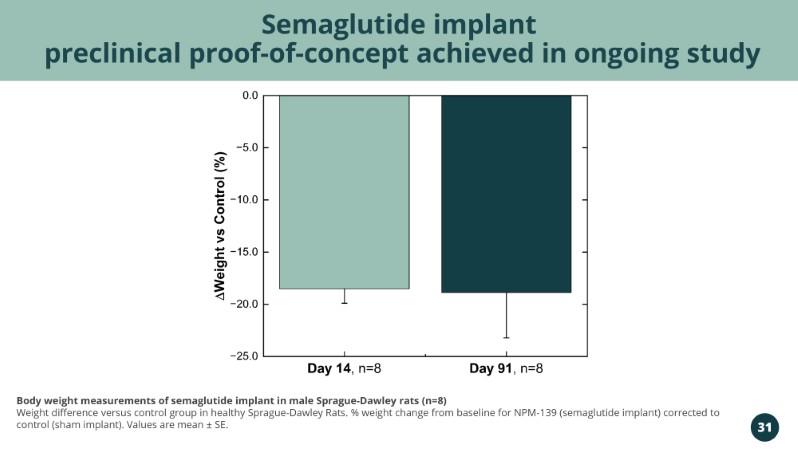
Semaglutide implant preclinical proof-of-concept achieved in ongoing study 31 Body weight measurements of semaglutide implant in male Sprague-Dawley rats (n=8) Weight difference versus control group in healthy Sprague-Dawley Rats. % weight change from baseline for NPM-139 (semaglutide implant) corrected to control (sham implant). Values are mean ± SE.4

Vivani Medical, Inc. Financial Information
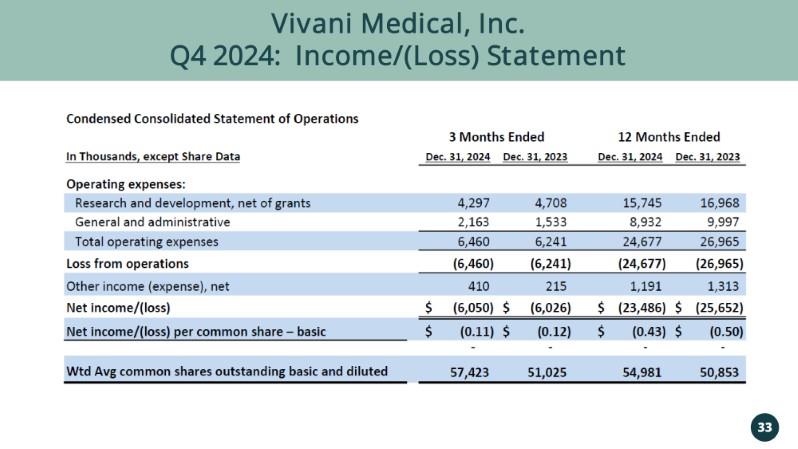
Vivani Medical, Inc. Q4 2024: Income/(Loss) Statement
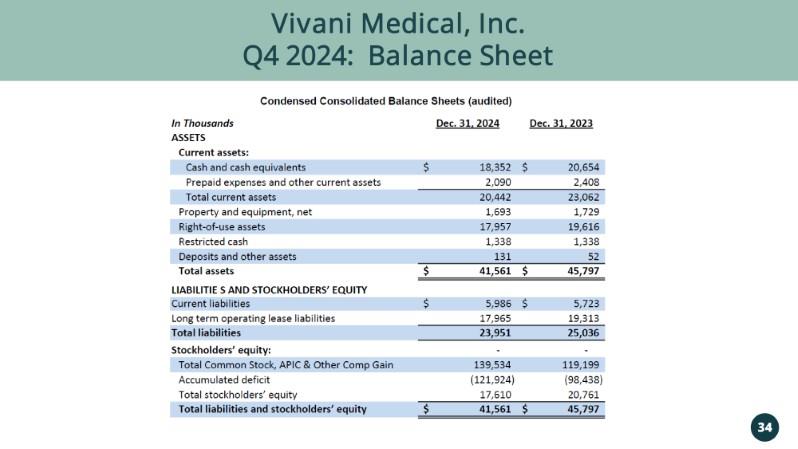
Vivani Medical, Inc. Q4 2024: Balance Sheet
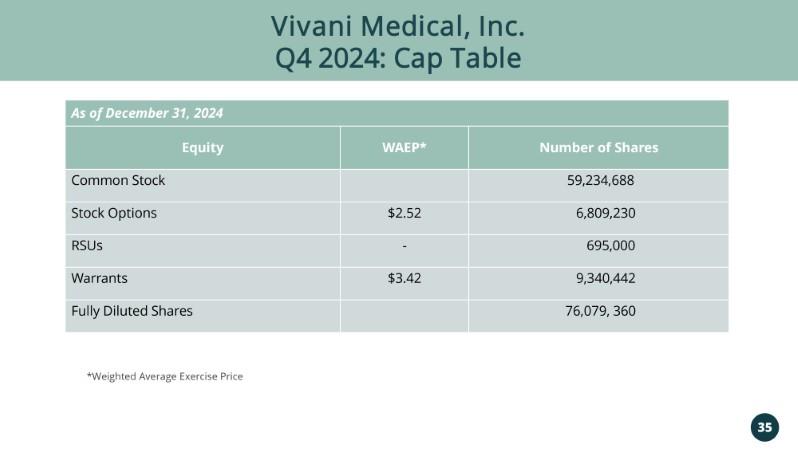
Vivani Medical, Inc. Q4 2024: Cap Table 35 As of December 31, 2024 Equity WAEP* Number of Shares Common Stock 59,234,688 Stock Options $2.52 6,809,230 RSUs - 695,000 Warrants $3.42 9,340,442 Fully Diluted Shares 76,079, 360 *Weighted Average Exercise Pric
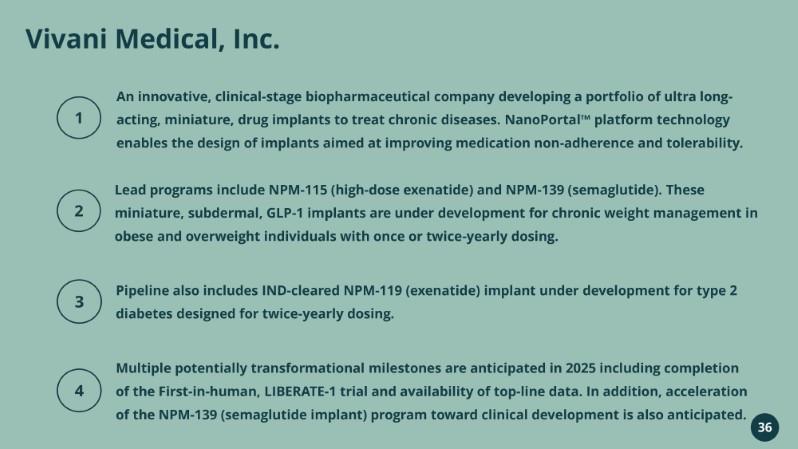
Vivani Medical, Inc. 36 Lead programs include NPM-115 (high-dose exenatide) and NPM-139 (semaglutide). These miniature, subdermal, GLP-1 implants are under development for chronic weight management in obese and overweight individuals with once or twice-yearly dosing. Pipeline also includes IND-cleared NPM-119 (exenatide) implant under development for type 2 diabetes designed for twice-yearly dosing. An innovative, clinical-stage biopharmaceutical company developing a portfolio of ultra longacting, miniature, drug implants to treat chronic diseases. NanoPortal platform technology enables the design of implants aimed at improving medication non-adherence and tolerability. Multiple potentially transformational milestones are anticipated in 2025 including completion of the First-in-human, LIBERATE-1 trial and availability of top-line data. In addition, acceleration of the NPM-139 (semaglutide implant) program toward clinical development is also anticipated